It's time to start solids and you might be feeling torn between spoon-feeding purees or baby led weaning. In this article, you'll learn the pros and cons of each and whether or not it's possible to combine the two approaches.
Regardless of which method you choose, what's most important is that it allows you and the child to follow responsive feeding practices from the start.
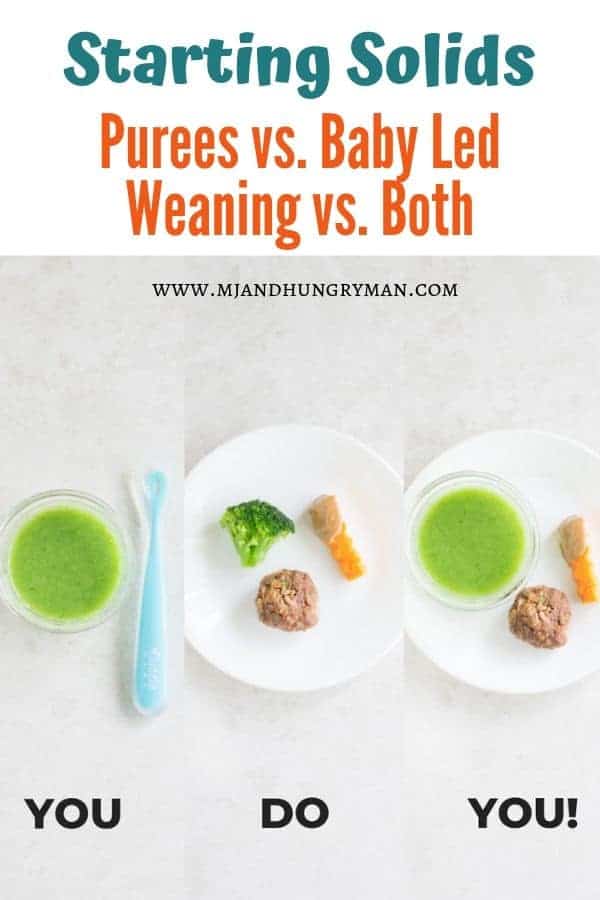
Food is so much more than fuel for the body. It’s a way to connect, make memories, share happiness and sadness, and feel safe and loved. As parents, being able to nourish our children through food is one of the greatest joys in parenthood.
It’s no wonder that we look forward to starting solids with much anticipation and excitement. And what a huge milestone it is!
At this time, parents may choose either traditional method of spoon-feeding smooth purees (moving up to lumps, chunks, finger foods and family foods) or baby led weaning approach where the baby is introduced to finger foods from the start.
Unfortunately, there are so many mixed messages out there and debates about which method is more superior. Before I share my personal opinion, let’s consider the pros and cons of each.
Jump to:
Purees
Pros
- Peace of mind that the food will be consumed safely.
- Can know for certain how much food was actually consumed.
- Less messy.
- Possibly more positive support from family members.
- Easier when other caregivers are involved in the baby’s feeding.
Cons
- While it can be baby led, it’s easier for parents to take control and ignore baby’s hunger/fullness cues.
- Time-consuming to cook, blend, freeze separate foods.
- Harder to eat at the same time as the baby as you have to actively feed your baby.
Baby Led Weaning
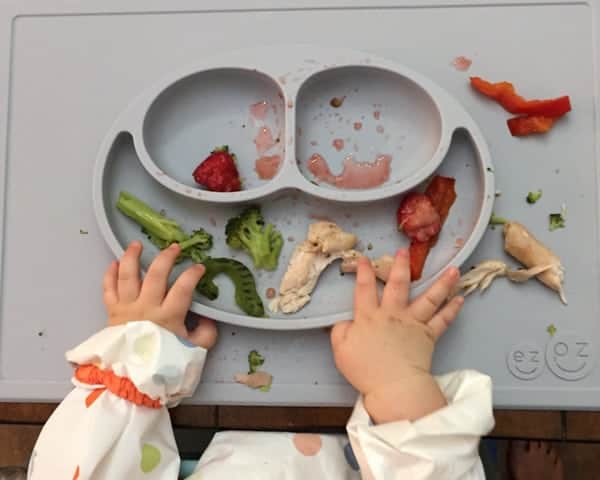
Pros:
- Food preparation is not as time-consuming as you can offer family foods with modifications.
- Babies set the pace. Being in full control of how much and whether or not to eat allows the child to be in tune with and respect her inner hunger and fullness cues. It fosters confidence and body trust. That means better appetite control and potentially less health and weight concerns in the future.
- Introduce babies to different textures from the start so the transition through texture may go more smoothly. Research also shows that being exposed to a wide variety of flavors and textures before the age of 1 promotes greater acceptance of foods and may minimize picky eating later on in life (source).
- Parents can eat at the same time as baby.
- As the baby explores food through sight, touch, smell, and taste, it’s not only invaluable for sensory development but also for developing hand-eye coordination, dexterity, and chewing skills. Not to mention, when not pressured to eat a set amount or specific food, it boosts confidence and enjoyment during mealtimes.
Cons:
- Concerns around gagging and choking. Gagging is a normal and expected part of learning to eat. And when blw is done properly (check out my post "how to serve the right size and texture"), the risk of choking is actually no higher than spoon feeding with purees (source). Despite knowing this, seeing your child gagging is extremely terrifying for you.
- Not knowing for certain whether your baby consumed enough food. It’s true that not much food will actually be swallowed during the first several weeks.
- The mess is real!!
- Food waste.
- The length of mealtime. I remember our meals lasted at least 30 minutes.
- Possible opposition/lack of support from family members.
Purees vs. Baby Led Weaning
So what do I think?
I personally hate that there’s such a strong division between the traditional and baby led weaning approach and that parents are made to feel guilty or inadequate for not strictly following one over the other.
While I decided to do baby led weaning because it’s what worked best for me and my family, I absolutely don’t think it’s all-or-nothing or the end-all-be-all! We should approach this fun and exciting learning/bonding time as just that rather than trying to follow a strict set of rules.
Important factors to consider
Regardless of whichever method you choose, what’s most important is that it allows you to:
- Practice responsive feeding. This basically means being in tune with your baby’s developmental cues and abilities and following your baby’s lead. We, as parents, need to observe and listen to our babies very closely and feed according to their hunger and satiety cues. By doing so, you're helping to set the foundation for appetite regulation and healthy, mindful eating!
- Help your baby to enjoy a wide variety of flavors and textures during the first year (click here for the list of 100 foods I introduced to my baby during the first 3 months).
- Provide plenty of opportunities for your baby to build self-feeding skills.
- Meet the baby's nutritional needs – focus on iron-rich and high-calorie foods, introduce the common allergens from the beginning.
- Be calm and present during mealtimes. If you’re anxious, fearful, etc., your baby will sense the negative energy, which can lead to a not-so-pleasant eating experience.
Responsive Feeding
Let’s now address some of these points with respect to the feeding approaches.
What really attracted me to BLW was that it truly allowed me to practice responsive feeding 100%. Children have an innate ability to self-regulate (incredible, right?!).
And it is our job as parents to decide what, when, and where the child eats, while it’s up to the child to decide how much and whether or not to eat.
This feeding model by Ellyn Satter is called the Division of Responsibility, and it is supported by many organizations, including The Academy of Nutrition and Dietetics and The American Academy of Pediatrics as the best practice for raising competent, joyous eaters.
That’s not to say this can’t be accomplished with spoon-feeding. But you must be very mindful about not falling into the temptation of having your child finish everything that’s in the bowl.
Instead, watch for and honor your child’s cues and offer only when their mouth is opened. Some other signs of hunger to look for are: moving their hands to their mouth or putting things in their mouth, making sucking noises or motions, clenching their fingers or fists over their chest and tummy, flexing their arms and legs.
Avoid forcing the spoon or coaxing them to open their mouth. That means no playing airplane. If your baby starts to push the spoon away, turns the head away, gets distracted or disinterested, spits out, etc., then it’s time to end the meal.
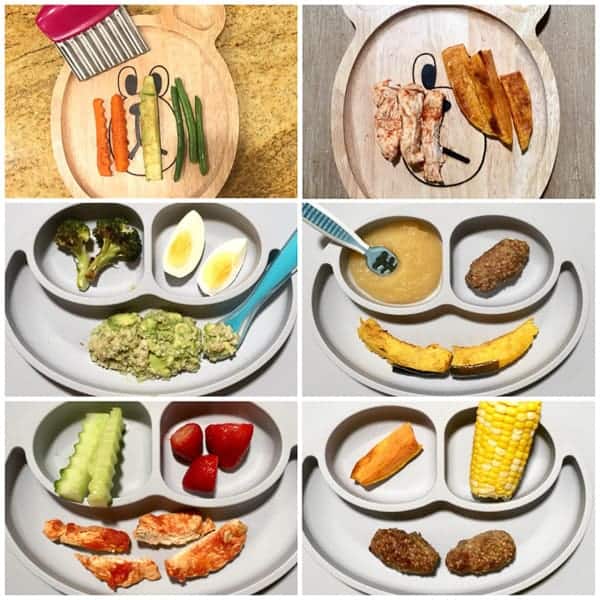
The importance of offering variety
Another advantage of baby led weaning is that it allows the baby to be exposed to a wide variety of flavors AND textures from the start.
If you decide to take the traditional approach and start with purees, it’s important that you transition from purees by 9 months and move forward with texture (so going from thin to thick to foods mashed with fork --> foods with lumps --> and finger foods).
It’s quite normal for babies to refuse foods initially when different texture is first introduced. So don’t fall back to serving just thin purees. Keep moving forward!
Research shows that infants who were introduced to lumpy solids by 9 months had less feeding problems and greater food acceptance.
Meeting the iron needs
Here’s what I struggled with the most – not knowing if my baby consumed enough food to meet his nutritional needs, especially iron. By 6 months of age, your baby’s iron stores begin to diminish.
And while the breastmilk contains iron that is easily absorbed, it’s not enough to meet the high requirements your baby needs to support the rapid growth and development.
However, what helped put my mind at ease was knowing that when parents are educated on what foods to focus on and serve, there was no significant difference in iron intake or status between spoon-fed infants and infants following the BLW approach (source).
I want to note that in this particular study, iron intakes were low in both groups. What this tells us is that we need to be extra mindful and proactive about serving an iron-rich food at every mealtime! That is #1 priority when it comes to nutrition.
How to build a plate for baby
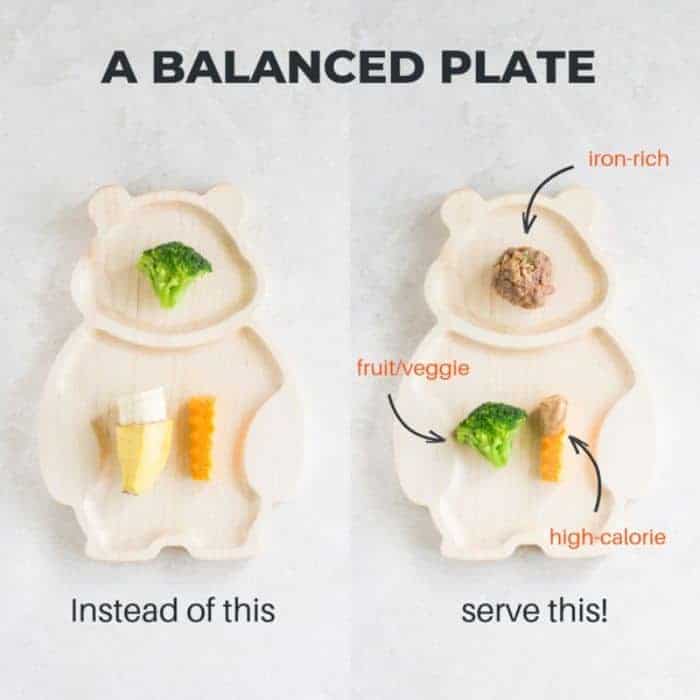
Here are the key points to remember (source):
- Offer foods that the infant can pick up and feed themselves
- Offer one iron-rich food at each meal
- Offer one high-energy food at each meal
- Offer a fruit and/or vegetable. I'm answering one of the most common questions - should you introduce fruits or vegetables first?
- Offer food prepared in a way that is suitable for the infant’s developmental age to reduce the risk of choking, and avoid offering foods listed as high-choking-risk foods
- Here are some breakfast ideas
You may also be interested in: 60+ Healthy Baby Led Weaning Recipes
Baby Led Feeding Journey Course
Over the years, as a mom of two, I’ve learned that we all share the same challenges and anxieties when it comes to starting solids. If you’re anything like me and other moms I know we wonder...
Is my baby getting the most optimal nutrition? What foods should I start off with? Is this food safe? Won’t it cause choking? How can I adapt family meals for baby? How do I introduce the allergens? And most importantly, how do I do all this without spending hours that I don’t have slaving away in the kitchen
Time is of the essence for us busy mamas and decision fatigue is REAL, right?
I GUARANTEE this program is going to save you time, energy, and money while feeding your baby (and your family) delicious meals that contain all the essential nutrients your baby needs to grow and thrive.
You do You!
I know that was a lot to read through and digest. At this point, I invite you to take a moment to drown out all the outside noise and search inward.
Consider your baby’s development, your patience, and personal preferences.
Ask yourself - which method will help you to keep your sanity and composure? What is your maternal instinct telling you? What do you feel most comfortable and confident doing? How much does the approval and support of your family mean to you? What would help make this new journey the most pleasant one?
For some of you, all this contemplation may not even be necessary! Your baby might absolutely refuse to be fed and wants to self-feed from the start. Or your baby just isn’t interested in finger foods at all but will happily eat purees (but remember, you want to transition from this stage rather quickly)
Combination Approach
Now, there’s one approach I haven’t discussed yet and that’s the combination approach! I love the idea of flexible feeding as every baby is different and every parent is different.
Some babies take to self-feeding right away. Some need more time. Some gag more. Some gag less. Some love to eat from the start and will eat just about anything. Some need lots of exposure and gentle pressure.
If taking a combination approach of purees and finger foods to start puts your mind at ease and works best for you and your baby, then I say trust your judgment!
Even if you start out doing strictly purees, you can certainly offer finger foods for your baby to play with and explore once you and your baby feel ready! It will be great for motor skills practice and help make the transition to self-feeding smoother.
You can also try offering finger foods outside of mealtimes when they're not hungry. This may help minimize frustration while learning.
Note: mixing texture does NOT increase the risk of choking or “confuse” your baby. Our babies are incredibly resilient and adaptable (I wish I was still this way!) and when given the chance, they will totally figure it out.
Our role as parents
I know I mentioned this above, but to reiterate. Regardless of whatever method you choose, our job as parents are:
- To offer nutrient-dense foods served in an age-appropriate way.
- To stay attuned to our baby’s needs and abilities, allowing them to lead the way.
- To create a safe and positive eating environment. Rather than focusing on how much and what food is/isn't being eaten, make mealtimes be about enjoying one another’s company and creating lots of memories around the table. This is the key to raising a happy and healthy eater! I always think about how days are long but years even shorter.
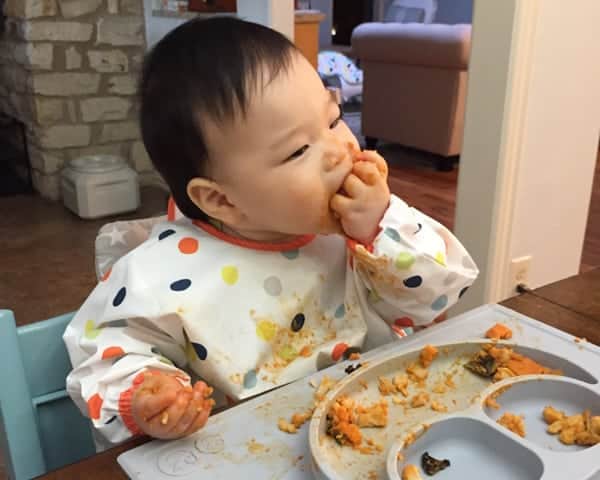
The best feeding method is one that allows your baby to meet their nutrient needs, learn new eating skills, and enjoy food.
I hope reading this helped put your mind at ease and gave you an extra boost of encouragement and knowledge to embark on this incredible journey of starting solids with much confidence and joy!
I'd love to know! If you're just embarking on this journey, which method are you leaning towards? If you're past this stage, which method did you take? If you found this post helpful, please share this post! Thank you ;).
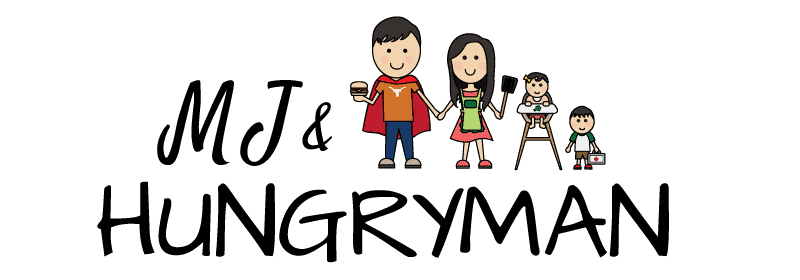
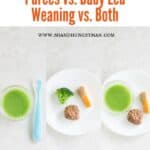
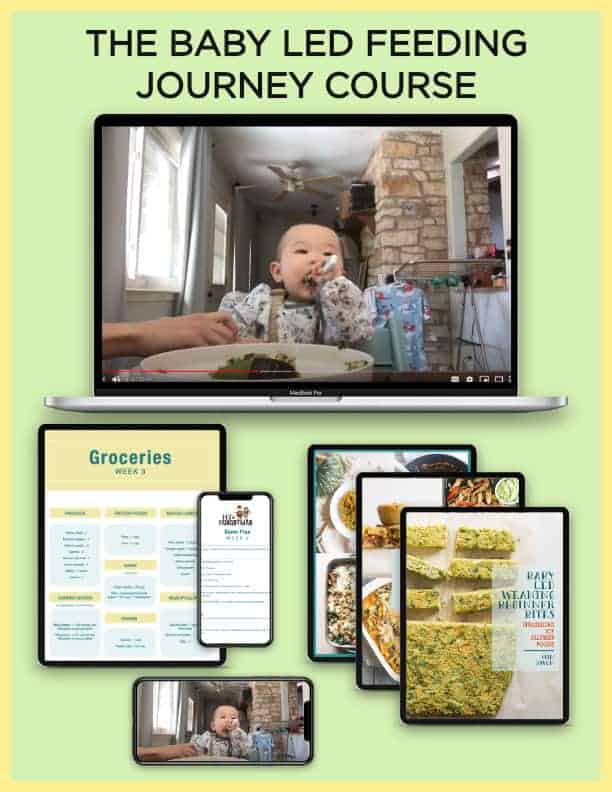
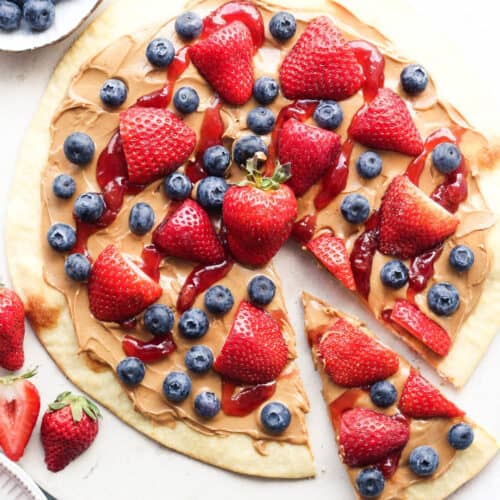
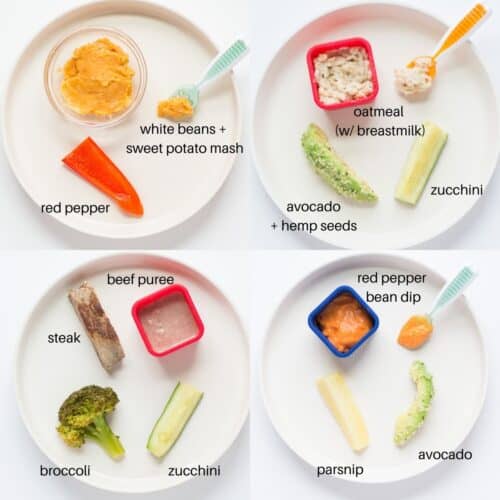
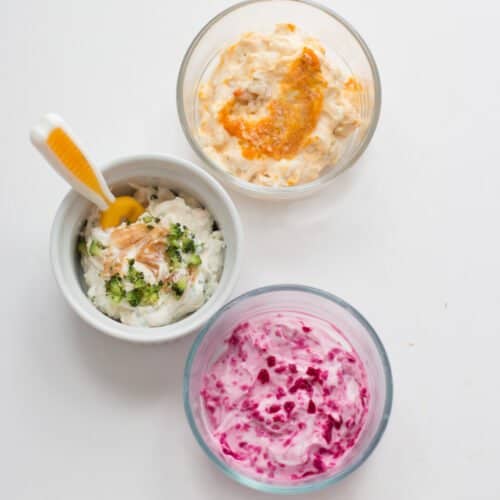
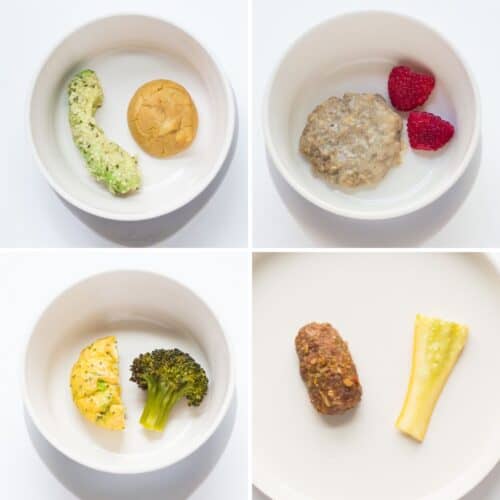

Yva says
Hi Min
I am so grateful for your post here as I struggle with my approach. I have been mixing spoon feeding and baby led feeding since my son was ready to start solids, but I feel I haven't been too successful at raising an independent eater. He is 17 months now and I still don't feel I have established a good selection of foods that he will eat. It feels as if his appetite and food preferences are unpredictable and inconsistent. Meaning one day he will be willing to eat something and the next day he won't. Some days I can tell he is hungry but when I serve him what is on the "menu" he turns away. I then ( out of concern for his nutritional intake) have resorted to preparing second and third meals for him, which is exhausting. My concern is his iron intake of course and also of concern, I noticed he is still quite sensitive to gagging and have on occasion thrown up his food. The size of food he can handle in his mouth is quite small (size of ezpz spoon) and he tends to spit anything out that isn't smooth. My question is from your perspective, are there any red flags for anything I should look further into given he still has a strong gag reflex? Do you have any advice on how I can improve his feeding habits at his age? Is it ok for me to end meals knowing he hasn't consume much at his age or is that not advised from a nutritional intake perspective?
Thanks in advance!
Yva
Min says
Hi mama! Thanks for reading. I can most definitely understand your concern. Picky eating is a normal part of development in toddlers. However, if his gag reflex continues to be hyperactive and seeing that he seems really sensitive to texture, what I'd do is consult with your healthcare provider and feeding therapist to rule out any underlying barriers! Hope this helps.